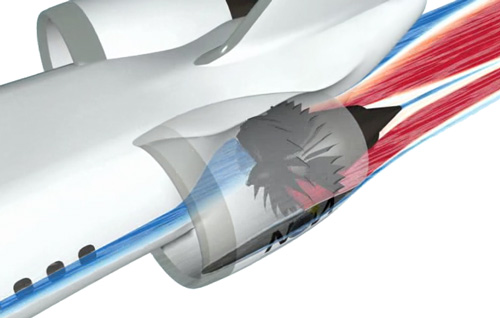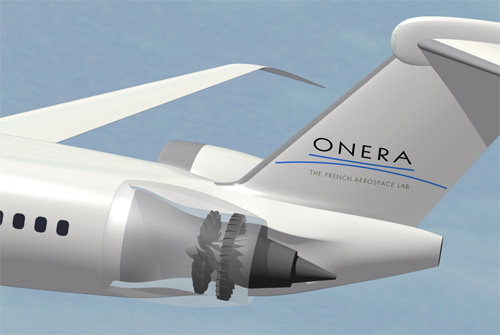We must therefore consider game changing aircraft configurations to face many challenges: ambitious environmental targets, depletion of oil resources and the cost reduction of aircraft operation.
Artist's representation of NOVA BLI (NOVA with Boundary layer ingestion) ©ONERA
Current aircraft are the direct heirs of aerodynamic and propulsive formulas developed in the 50s and 60s. These fuselage –low wing - under-wing engines aircrafts have been optimized over the last 50 years. Technical progress has enabled a considerable reduction in fuel consumption, noise and emissions. But the remaining gains to be obtained by this scheme are now very low. We must therefore consider game changing aircraft configurations to face many challenges: ambitious environmental targets, depletion of oil resources and the cost reduction of aircraft operation. Challenges even more ambitious since the multiplication, at least by two, of air traffic is expected for 2030.
What is NOVA ?
NOVA is a concept of medium-haul transport aircraft taking advantage of several disruptive technologies. Four configurations have been developed by ONERA to explore different possibilities for UHBR (Ultra High Bypass Ratio) engine integration. NOVA is designed to carry 180 passengers on 3000 nautical miles (equivalent to a B737-900) at Mach 0,82 and targets a 2030 entry-into-service.
Main features

Boundary layer ingestion increases rhe propulsive efficiency
NOVA aims at propulsive efficiency improvement and drag reduction. To do so, it differs from a conventional aircraft configuration by the following characteristics:
- UHBR Geared turbofan (GTF) engines (Bypass Ratio = 16). These engines are more fuel-efficient and more silent than todays, but also larger and heavier, so that their integration on the aircraft is a challenge.
- Innovative engine integration options to mitigate the drawbacks related to the engine size, like compliance to ground clearance limitations for instance. For under-wing engines, the possibility of modifying the wing dihedral angle in its inner portion has been investigated and lead to a “gull-wing” shape. Aft fuselage mounted engines have also been investigated, conventionally podded, or semi-buried in the fuselage and fed by a boundary layer ingesting air intake for increased propulsive efficiency.
- A high aspect ratio wingwith downward-oriented winglets, for a better balance between aerodynamics (drag reduction) and structure (embedment moment at the wing root).





